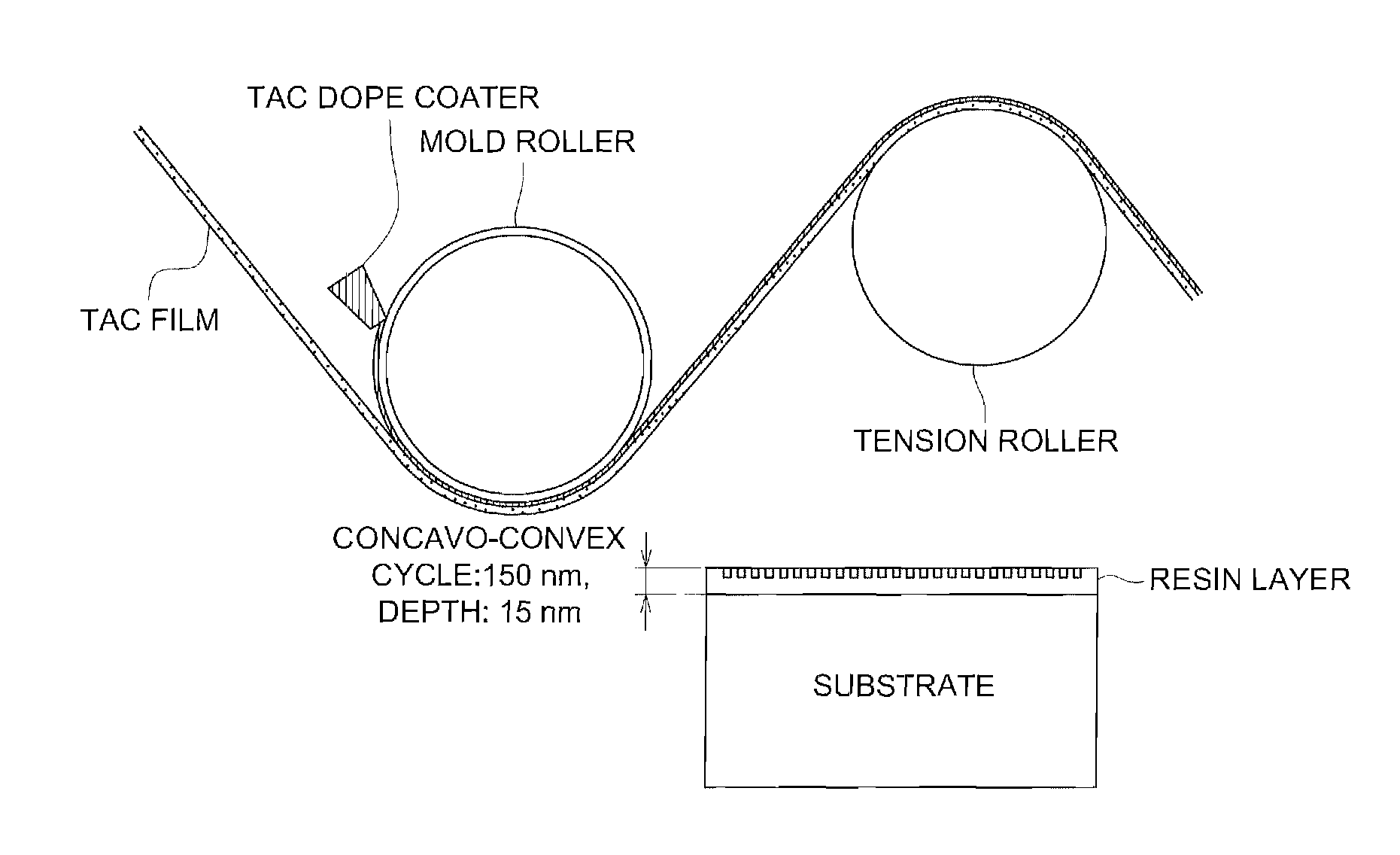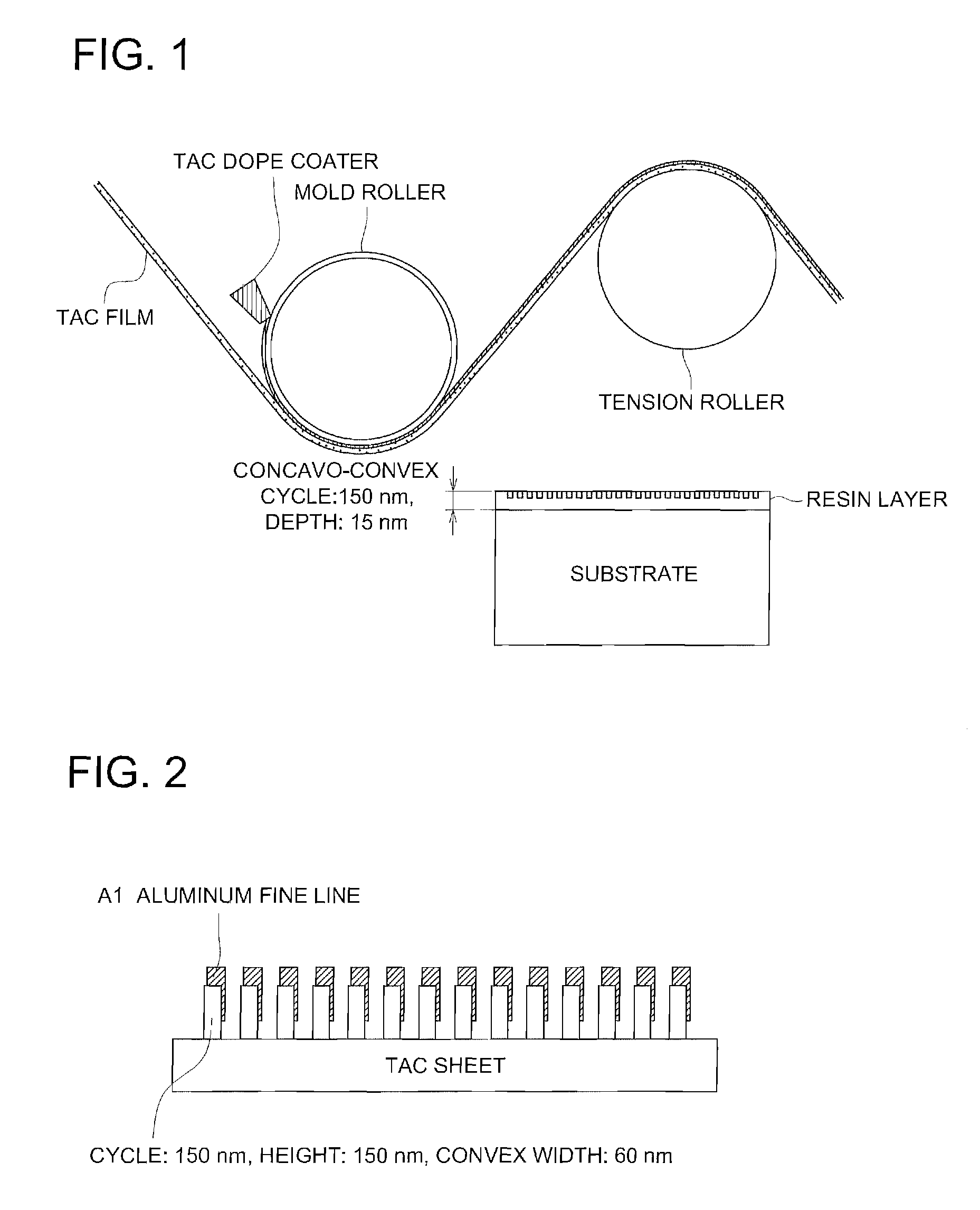Method for manufacturing an optical film having a convexoconcave structure
a manufacturing method and optical film technology, applied in the direction of instruments, polarising elements, other domestic articles, etc., can solve the problems of long transfer time, difficult to press a large-area mold against the sheet, and low productivity, and achieve the effect of high degree of productivity
- Summary
- Abstract
- Description
- Claims
- Application Information
AI Technical Summary
Benefits of technology
Problems solved by technology
Method used
Image
Examples
example 1
Synthesizing Example 1
Cellulose Ester
The following cellulose ester was synthesized referring Tokuhyou Hei 6-501040 and by controlling the adding amount of propionic acid and acetic acid.
C-1 (Acetylation degree: 1.4, Propionylation degree: 1.4, Total acylation degree: 2.8)
Synthesizing Example 2
Synthesis of Compound 103 and 103A Represented by Formula R
[1678]A mixture of 3-(3,4-dimethylphenyl)-5,7-di-tert-butyl-3H-benzo-furan-2-one (Compound 103) and 3-(2,3-dimethylphenyl)-5,7-di-tert-butyl-3H-benzofuran-2-one (Compound 103A isomer) in a ratio of 5.7:1 was synthesized from 2,4-di-tert-butyl-phenol, glyoxylic acid, o-xylene and Fulcat or Flumont as a catalyst.
[1679]Into a 1,500 ml double layer reacting vessel having a moisture separation device, 206.3 g (1 mole) of 2,4-di-tert-butyl-phenol, 485 g (5.5 moles) of o-xylene, 0.5 g of p-toluenesulfonic acid monohydrate (2.6 mmoles) and 163 f id 50% aqueous solution of glyoxylic acid (1.1 moles) were charged. The mixture was heated by a temp...
example 2
[1718]Metal fine lines of aluminum were formed at the concave portions of each of the cellulose ester films having the convexoconcave patters in the surface thereof prepared in Example 1.
[1719]The metal was put only on the concave portion of the film surface having the convexoconcave structure by vapor depositing the metal at a slanted direction. The thickness of the aluminum was 100 nm.
[1720]Thus prepared film on which the aluminum fine lines were formed had properties that the film permeated light polarized in the perpendicular direction to the fine lines and reflected light polarized in the direction of the fine lines. It could be confirmed that the luminance at the front surface of a liquid crystal display was raised by 1.4 times when the film was used as the luminance increasing film for the backlight of the liquid crystal display.
[1721]The cellulose ester films having the convexoconcave structure prepared in Example 1 were each subjected to the saponification treatment and use...
PUM
| Property | Measurement | Unit |
|---|---|---|
| time | aaaaa | aaaaa |
| diameter | aaaaa | aaaaa |
| size | aaaaa | aaaaa |
Abstract
Description
Claims
Application Information
 Login to View More
Login to View More - R&D
- Intellectual Property
- Life Sciences
- Materials
- Tech Scout
- Unparalleled Data Quality
- Higher Quality Content
- 60% Fewer Hallucinations
Browse by: Latest US Patents, China's latest patents, Technical Efficacy Thesaurus, Application Domain, Technology Topic, Popular Technical Reports.
© 2025 PatSnap. All rights reserved.Legal|Privacy policy|Modern Slavery Act Transparency Statement|Sitemap|About US| Contact US: help@patsnap.com



